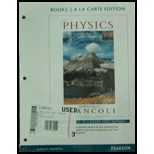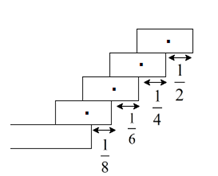
Physics
7th Edition
ISBN: 9780321929013
Author: Douglas C. Giancoli
Publisher: PEARSON
expand_more
expand_more
format_list_bulleted
Concept explainers
Question
Chapter 9, Problem 39P
(a)
To determine
ToShow: Successive bricks must extend no more than (starting at the top)

(b)
To determine
Whether the top brick is completely beyond the base.
(c)
To determine
Ageneral formula for the maximum total distance spanned by
(d)
To determine
The minimum number of bricks each
Expert Solution & Answer
Want to see the full answer?
Check out a sample textbook solution
Students have asked these similar questions
A worker lifts a box under the following conditions:Horizontal distance (H): 30 cmInitial height (V): 60 cmVertical travel (D): 50 cmTorso rotation (A): 30°Frequency: 3 times/minute for 1 hourGrip: Good
Question:What is the RWL for this task?What does this value mean in terms of occupational safety?
Can someone help
Can someone help me
Chapter 9 Solutions
Physics
Ch. 9 - Prob. 1OQCh. 9 - Describe several situations in which an object is...Ch. 9 - Prob. 2QCh. 9 - You can find the center of gravity of a meter...Ch. 9 - Prob. 4QCh. 9 - A ground retaining wall is shown in Fig. 9-36a...Ch. 9 - Can the sum of the torques on an object be zero...Ch. 9 - A ladder, leaning against a wall, makes a 60°...Ch. 9 - A uniform meter stick supported at the 25-cm mark...Ch. 9 - Why do you tend to lean backward when carrying a...
Ch. 9 - Figure 9-38 shows a cone. Explain how to lay it on...Ch. 9 - Prob. 11QCh. 9 - Why is it not possible to sit upright in a chair...Ch. 9 - Why is it more difficult to do sit-ups when your...Ch. 9 - Explain why touching your toes while you are...Ch. 9 - Prob. 15QCh. 9 - Name the type of equilibrium for each position of...Ch. 9 - (
17.
)
Is the Young's modulus for a bungee cord...Ch. 9 - Prob. 18QCh. 9 - Prob. 19QCh. 9 - A 60-kg woman stands on the very end of a uniform...Ch. 9 - Prob. 2MCQCh. 9 - Prob. 3MCQCh. 9 - Prob. 4MCQCh. 9 - Two children are balanced on opposite sides of a...Ch. 9 - Prob. 6MCQCh. 9 - Prob. 7MCQCh. 9 - Prob. 8MCQCh. 9 - Prob. 9MCQCh. 9 - Prob. 10MCQCh. 9 - Three forces are applied to a tree sapling, as...Ch. 9 - Prob. 2PCh. 9 - 3(I) A tower crane ( Fig. 9-48a) must always be...Ch. 9 - What is the mass of the diver in Fig. 9-49 if she...Ch. 9 - Prob. 5PCh. 9 - Figure 9-50 shows a pair of forceps used to hold a...Ch. 9 - Prob. 7PCh. 9 - The two trees in Fig. 9-51 are 6.6 m apart. A...Ch. 9 - Prob. 9PCh. 9 - Prob. 10PCh. 9 - Prob. 11PCh. 9 - Find the tension in the two cords shown in Fig....Ch. 9 - Prob. 13PCh. 9 - Prob. 14PCh. 9 - The force required to pull the cork out of the top...Ch. 9 - Prob. 16PCh. 9 - Three children are trying to balance on a seesaw,...Ch. 9 - A shop sign weighing 215 N hangs from the end of a...Ch. 9 - Prob. 19PCh. 9 - Prob. 20PCh. 9 - Prob. 21PCh. 9 - 22 (II) A 20.0-m-long uniform beam weighing 650 N...Ch. 9 - Prob. 23PCh. 9 - Prob. 24PCh. 9 - Prob. 25PCh. 9 - Prob. 26PCh. 9 - A uniform rod AB of length 5.0 m and mass M=3.S kg...Ch. 9 - You are on a pirate ship and being forced to walk...Ch. 9 - Prob. 29PCh. 9 - Prob. 30PCh. 9 - Prob. 31PCh. 9 - Prob. 32PCh. 9 - Prob. 33PCh. 9 - Prob. 34PCh. 9 - Prob. 35PCh. 9 - 36 (II) The Achilles tendon is attached to the...Ch. 9 - If 25 kg is the maximum mass m that a person can...Ch. 9 - Prob. 38PCh. 9 - Prob. 39PCh. 9 - Prob. 40PCh. 9 - A marble column of cross-sectional area 1.4 m2...Ch. 9 - Prob. 42PCh. 9 - A sign (mass 1700 kg) hangs from the bottom end of...Ch. 9 - Prob. 44PCh. 9 - Prob. 45PCh. 9 - Prob. 46PCh. 9 - A steel wire 2.3 mm in diameter stretches by...Ch. 9 - Prob. 48PCh. 9 - Prob. 49PCh. 9 - Prob. 50PCh. 9 - Prob. 51PCh. 9 - Prob. 52PCh. 9 - (a) What is the minimum cross-sectional area...Ch. 9 - Prob. 54PCh. 9 - Prob. 55PCh. 9 - Prob. 56PCh. 9 - Prob. 57PCh. 9 - Prob. 58GPCh. 9 - Prob. 59GPCh. 9 - Prob. 60GPCh. 9 - Prob. 61GPCh. 9 - Prob. 62GPCh. 9 - Prob. 63GPCh. 9 - Prob. 64GPCh. 9 - When a mass of 25 kg is hung from the middle of a...Ch. 9 - Prob. 66GPCh. 9 - Prob. 67GPCh. 9 - Prob. 68GPCh. 9 - Prob. 69GPCh. 9 - Prob. 70GPCh. 9 - Prob. 71GPCh. 9 - Prob. 72GPCh. 9 - Prob. 73GPCh. 9 - A 2.0-m-high box with a 1.0-m-square base is moved...Ch. 9 - Prob. 75GPCh. 9 - Prob. 76GPCh. 9 - Prob. 77GPCh. 9 - Prob. 78GPCh. 9 - In a mountain-climbing technique called the...Ch. 9 - Prob. 80GPCh. 9 - A cubic crate of side s=20m is top-heavy: its cgis...
Additional Science Textbook Solutions
Find more solutions based on key concepts
Choose the best answer to each of the following. Explain your reasoning. An astronomical unit is (a) any planet...
Cosmic Perspective Fundamentals
9. A student gives a steady push to a ball at the end of a massless, rigid rod for 1 s, causing the ball to rot...
College Physics: A Strategic Approach (3rd Edition)
EVOLUTION CONNECTION The percentages of naturally occurring elements making up the human body (see Table 2.1) a...
Campbell Biology (11th Edition)
1.3 Obtain a bottle of multivitamins and read the list of ingredients. What are four chemicals from the list?
Chemistry: An Introduction to General, Organic, and Biological Chemistry (13th Edition)
Two culture media were inoculated with four different bacteria. After incubation, the following results were ob...
Microbiology: An Introduction
60. You are 9.0 m from the door of your bus, behind the bus, when it pulls away with an acceleration of 1.0 m/...
Physics for Scientists and Engineers: A Strategic Approach, Vol. 1 (Chs 1-21) (4th Edition)
Knowledge Booster
Learn more about
Need a deep-dive on the concept behind this application? Look no further. Learn more about this topic, physics and related others by exploring similar questions and additional content below.Similar questions
- 3. Four identical small masses are connected in a flat perfect square. Rank the relative rotational inertias (IA, IB, IC) about the three axes of rotation shown. Axes A and B are in the plane of the square, and axis C is perpendicular to the plane, through mass m1. ΙΑ IB m2 m1 m3 Ic m4 (a) IAarrow_forwardConsider the circuit shown in the figure below. (Assume L = 5.20 m and R2 = 440 Ω.) (a) When the switch is in position a, for what value of R1 will the circuit have a time constant of 15.4 µs? (b) What is the current in the inductor at the instant the switch is thrown to position b?arrow_forwardCan someone helparrow_forwardCan someone help mearrow_forwardA particle in a box between x=0 and x=6 has the wavefunction Psi(x)=A sin(2πx). How muchenergy is required for the electron to make a transition to Psi(x)= A’ sin(7π x/3). Draw anapproximate graph for the wavefunction. Find A and A'arrow_forwardA proton is moving with 10^8 m/s speed. Find the De Broglie wavelength associated with theproton and the frequency of that wave.arrow_forwardFind the wavelength of the photon if a (Li--) electron makes a transition from n=4 to n=3. Findthe Bohr radius for each state.arrow_forwardA photon with wavelength 3000 nm hits a stationary electron. After the collision electron isscattered to 60 degrees. Find the wavelength and frequency of the scattered photon.arrow_forwardA metal has threshold frequency 10^15. Calculate the maximum kinetic energy of the ejectedelectron if a laser beam with wavelength 1.5 10^-7 m is projected on the metal.arrow_forwardDetermine the direction of the vector V, B, or ♬ that is missing from the pair of vectors shown in each scenario. Here, u is the velocity vector of a moving positive charge, B is a constant and uniform magnetic field, and F is the resulting force on the moving charge. 1. 2. 3. B OB F 4. ↑F F 5. 怔 ↑ ↑F Answer Bank 6. ↑ TE Farrow_forwardTwo point charges (+9.80 nC and -9.80 nC) are located 8.00 cm apart. Let U=0 when all of the charges are separated by infinite distances. What is the potential energy if a third point charge q=-4.20 nC is placed at point b? 8.00 cm 8.00 cm 4.00 +4.00 +4.00- cm cm cm HJarrow_forward! Required information Two chloride ions and two sodium ions are in water, the "effective charge" on the chloride ions (CI¯) is −2.00 × 10-21 C and that of the sodium ions (Na+) is +2.00 x 10-21 C. (The effective charge is a way to account for the partial shielding due to nearby water molecules.) Assume that all four ions are coplanar. CT Na+ Na+ 30.0° 45.0% с сг L. where a = 0.300 nm, b = 0.710 nm, and c = 0.620 nm. What is the direction of electric force on the chloride ion in the lower right-hand corner in the diagram? Enter the angle in degrees where positive indicates above the negative x-axis and negative indicates below the positive x-axis.arrow_forwardarrow_back_iosSEE MORE QUESTIONSarrow_forward_ios
Recommended textbooks for you
 College PhysicsPhysicsISBN:9781305952300Author:Raymond A. Serway, Chris VuillePublisher:Cengage Learning
College PhysicsPhysicsISBN:9781305952300Author:Raymond A. Serway, Chris VuillePublisher:Cengage Learning University Physics (14th Edition)PhysicsISBN:9780133969290Author:Hugh D. Young, Roger A. FreedmanPublisher:PEARSON
University Physics (14th Edition)PhysicsISBN:9780133969290Author:Hugh D. Young, Roger A. FreedmanPublisher:PEARSON Introduction To Quantum MechanicsPhysicsISBN:9781107189638Author:Griffiths, David J., Schroeter, Darrell F.Publisher:Cambridge University Press
Introduction To Quantum MechanicsPhysicsISBN:9781107189638Author:Griffiths, David J., Schroeter, Darrell F.Publisher:Cambridge University Press Physics for Scientists and EngineersPhysicsISBN:9781337553278Author:Raymond A. Serway, John W. JewettPublisher:Cengage Learning
Physics for Scientists and EngineersPhysicsISBN:9781337553278Author:Raymond A. Serway, John W. JewettPublisher:Cengage Learning Lecture- Tutorials for Introductory AstronomyPhysicsISBN:9780321820464Author:Edward E. Prather, Tim P. Slater, Jeff P. Adams, Gina BrissendenPublisher:Addison-Wesley
Lecture- Tutorials for Introductory AstronomyPhysicsISBN:9780321820464Author:Edward E. Prather, Tim P. Slater, Jeff P. Adams, Gina BrissendenPublisher:Addison-Wesley College Physics: A Strategic Approach (4th Editio...PhysicsISBN:9780134609034Author:Randall D. Knight (Professor Emeritus), Brian Jones, Stuart FieldPublisher:PEARSON
College Physics: A Strategic Approach (4th Editio...PhysicsISBN:9780134609034Author:Randall D. Knight (Professor Emeritus), Brian Jones, Stuart FieldPublisher:PEARSON

College Physics
Physics
ISBN:9781305952300
Author:Raymond A. Serway, Chris Vuille
Publisher:Cengage Learning

University Physics (14th Edition)
Physics
ISBN:9780133969290
Author:Hugh D. Young, Roger A. Freedman
Publisher:PEARSON

Introduction To Quantum Mechanics
Physics
ISBN:9781107189638
Author:Griffiths, David J., Schroeter, Darrell F.
Publisher:Cambridge University Press

Physics for Scientists and Engineers
Physics
ISBN:9781337553278
Author:Raymond A. Serway, John W. Jewett
Publisher:Cengage Learning

Lecture- Tutorials for Introductory Astronomy
Physics
ISBN:9780321820464
Author:Edward E. Prather, Tim P. Slater, Jeff P. Adams, Gina Brissenden
Publisher:Addison-Wesley

College Physics: A Strategic Approach (4th Editio...
Physics
ISBN:9780134609034
Author:Randall D. Knight (Professor Emeritus), Brian Jones, Stuart Field
Publisher:PEARSON
An Introduction to Stress and Strain; Author: The Efficient Engineer;https://www.youtube.com/watch?v=aQf6Q8t1FQE;License: Standard YouTube License, CC-BY